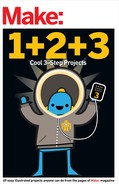
Springboard
By Casey Shea ■ Illustrations by Julie West
You will need
Plywood or soft wood, 4"×6"×¾"
Springs, 2" with loops on ends (2)
Springs, ½" with loops on ends (4–15)
Wood screws, ¾" (2 per spring)
Power drill
Battery (I used a 9V)
Snap battery connector 9V
I get a vicarious thrill watching young Makers’ eyes light up like the LEDs in the conductive dough they’re working with. But that feeling is too often followed by shared frustration at the increased difficulty when they switch to a solderless breadboard.
To ease the transition, I call back to duty the springboard, a 50-year-old relic that’s difficult to find these days, but is easy and cheap to make. The layout mimics a breadboard, so by the time students reach the limitations of the springboard, they’re ready to move onto a breadboard.
1. Design your board.
Lay out the springs (while not under tension) and mark where you’ll attach them to the board. The number of springs depends on the complexity of the circuits you’ll build. The most basic design has two vertical 2" springs on the left and right sides, with two rows of ½" springs running horizontally between them, two or three springs in each row. More complicated circuits require more rows. Space the springs so the legs of an LED can easily span two of them.
2. Screw down the springs.
Screw them down with your power drill, making sure that none of the screws are touching each other (finish nails are best for boards with closer spacing).

3. Energize!
Spread one of the 2" springs with a pointed object (like a multimeter probe) and insert the positive wire from the snap connector. Connect the negative wire to the other 2" spring. Complete the circuit by connecting individual components from spring to spring, using jumper wires when needed. Connect the battery to the snap connector. The springboard expresses the connected circuit visually and makes it much easier to practice using a multimeter at various locations. ![]()


Gunther Kirsch
Springboard Update
My original horizontal-springboard was based on a classic design. I’ve since created an alternative design using vertical springs.
The motivation for designing the vertical model was to make it easier to use alligator-clip jumper wires as well as regular solid or stranded wire without the need of tools. The horizontal model requires some sort of sharp object to spread the springs wide enough to insert the wire. The vertical springs can just be pushed to the side with a finger to make a big enough opening to insert wires. As with the horizontal model, this is used only to make simple connections and to give users a better understanding of the function of a breadboard. The photos don't show it, but we often put long springs horizontally along the sides to simulate the rails.
The board is made by drilling holes slightly smaller than the spring diameter. It's really a trial and error process based upon the size of the springs used. The fit needs to be pretty tight for the springs not to pop out of the holes. We use a laser cutter in 1⁄8'' plywood, but drill bits in any thickness of wood should work fine as well. A bit of epoxy or hot glue in the bottom of the hole (or on the back side of the plywood) helps the springs to stay in place.


Casey Shea teaches math and Project Make at Analy High School in Sebastopol, CA—the hometown of MAKE:. In addition to teaching students the skills of making, he is interested in sharing with educators the ways modern tools can be used to create custom instructional materials for their classrooms.
